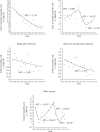Infant mortality trend in the city of Rio Branco, AC, 1999 to 2015
- PMID: 29641657
- PMCID: PMC5893275
- DOI: 10.11606/S1518-8787.2018052000280
Infant mortality trend in the city of Rio Branco, AC, 1999 to 2015
Abstract
Objective: Analyze the trend of infant mortality in Rio Branco, state of Acre, from 1999 to 2015.
Methods: An ecological observational study of a time series, in which data from deaths from the Information System on Mortality and Births of the Information System on Live Births were used. The annual percentage change was estimated using the Joinpoint software.
Results: The infant mortality rate decreased from 26.99 in 1999 to 14.50 in 2015 per 1,000 live births, with an annual percentage change of -4.37 (95%CI -5.4- -3.4). When stratified by age components, the neonatal period presented an annual percentage change of -4.73 (95%CI -5.7- -3.7), and the post-neonatal period was -3.7 (95%CI -5.4- -2.0). Avoidability, avoidable causes and poorly defined causes showed a downward trend throughout the period and causes not clearly preventable showed an upward trend until 2008. The group of causes that contributed most to the infant deaths during the period studied was perinatal diseases, followed by malformations, infectious and parasitic diseases, and respiratory diseases.
Conclusions: Despite the decreasing trend in infant mortality rates in the capital compared to developed countries, it is relatively high.
OBJETIVO: Analisar a tendência da mortalidade infantil em Rio Branco, AC, de 1999 a 2015.
MÉTODOS: Estudo observacional ecológico de série temporal, em que foram utilizados dados de óbitos do Sistema de Informações sobre Mortalidade e Nascimentos do Sistema de Informações sobre Nascidos Vivos. Estimou-se a variação percentual anual por meio do software Joinpoint.
RESULTADOS: A taxa de mortalidade infantil reduziu de 26,99, em 1999, para 14,50, em 2015, por 1.000 nascidos vivos, com variação percentual anual de -4,37 (IC95% -5,4– -3,4). Quando estratificada por componentes etários, o neonatal apresentou variação percentual anual de -4,73 (IC95% -5,7– -3,7), e o pós-neonatal de -3,7 (IC95% -5,4– -2,0). A evitabilidade, as causas evitáveis e as causas mal definidas apresentaram tendência descendente em todo o período e as causas não claramente evitáveis apresentaram tendência ascendente até 2008. O grupo de causas que mais contribuiu para os óbitos infantis no período estudado foi o das afecções perinatais, seguido pelo das malformações, das doenças infecciosas e parasitárias, e do grupo das doenças respiratórias.
CONCLUSÕES: Apesar da tendência decrescente da taxa de mortalidade infantil na capital, quando comparada à de países desenvolvidos, mostra-se relativamente elevada.
Conflict of interest statement
Figures



Similar articles
-
Trend of preventable deaths up to the 6th day of life in the state of São Paulo - 2008 to 2017.Rev Saude Publica. 2020 Dec 14;54:132. doi: 10.11606/s1518-8787.2020054002309. eCollection 2020. Rev Saude Publica. 2020. PMID: 33331526 Free PMC article.
-
Trends in neonatal mortality in Brazil from 2007 to 2017.Cien Saude Colet. 2022 Feb;27(2):567-578. doi: 10.1590/1413-81232022272.41192020. Epub 2021 Jan 28. Cien Saude Colet. 2022. PMID: 35137813 English, Portuguese.
-
[Trends in avoidable causes of infant mortality in Belo Horizonte, Brazil, 1984 to 1998].Rev Saude Publica. 2005 Feb;39(1):67-74. doi: 10.1590/s0034-89102005000100009. Epub 2005 Jan 11. Rev Saude Publica. 2005. PMID: 15654462 Portuguese.
-
Contextual, maternal, and infant factors in preventable infant deaths: a statewide ecological and cross-sectional study in Rio Grande do SUL, Brazil.BMC Public Health. 2023 Jan 12;23(1):87. doi: 10.1186/s12889-022-14913-z. BMC Public Health. 2023. PMID: 36631798 Free PMC article.
-
Epidemiological profile of mortality in indigenous children under five years of age in Brazil: an integrative literature review.Cien Saude Colet. 2025 Jan;30(1):e09342023. doi: 10.1590/1413-81232025301.09342023. Epub 2023 Dec 15. Cien Saude Colet. 2025. PMID: 39879457 Review. English, Portuguese.
Cited by
-
Infant mortality in the Metropolitan Region of São Paulo: an ecological study.Einstein (Sao Paulo). 2021 Aug 13;19:eAO5663. doi: 10.31744/einstein_journal/2021AO5663. eCollection 2021. Einstein (Sao Paulo). 2021. PMID: 34406314 Free PMC article.
-
Infant Mortality in a Brazilian Municipality with a High Human Development Index.Turk Arch Pediatr. 2022 Nov;57(6):630-636. doi: 10.5152/TurkArchPediatr.2022.22146. Turk Arch Pediatr. 2022. PMID: 36124358 Free PMC article.
References
-
- Ministério da Saúde (BR) Secretaria de Vigilância em Saúde. Secretaria de Atenção à Saúde . Manual de vigilância do óbito infantil e fetal e do Comitê de Prevenção do Óbito Infantil e Fetal. 2. Brasília (DF): 2009. [cited 2015 Oct 10]. Série A. Normas e Manuais Técnicos. http://bvsms.saude.gov.br/bvs/publicacoes/manual_obito_infantil_fetal_2e....
-
- França E, Lansky S. Rede Interagencial para a Saúde . Demografia e saúde: contribuição para análise de situação e tendências. Brasília (DF): Organização Pan-Americana da Saúde; 2009. [cited 2015 Oct 10]. Mortalidade infantil neonatal no Brasil: situação, tendências e perspectivas; pp. 83–112. Série G. Estatística e Informação em Saúde. Série Informe de Situação e Tendências. http://bvsms.saude.gov.br/bvs/publicacoes/demografia_saude_contribuicao_....
-
- Kassar SB, Melo AM, Coutinho SB, Lima MC, Lira PI. Determinants of neonatal death with emphasis on health care during pregnancy, childbirth and reproductive history. J Pediatr (Rio J) 2013;89(3):269–277. https://doi.org/10.1016/j.jped.2012.11.005. - DOI - PubMed
-
- Ribeiro VS, Silva AAM. Tendências da mortalidade neonatal em São Luís, Maranhão, Brasil, de 1979 a 1996. Cad Saude Publica. 2000;16(2):429–438. https://doi.org/10.1590/S0102-311X2000000200013. - DOI - PubMed
-
- Ferrari RAP, Bertolozzi MR. Postnatal mortality in Brazilian territory: a literature review. Rev Esc Enferm USP. 2012;46(5):1207–1214. https://doi.org/10.1590/S0080-62342012000500024. - DOI - PubMed
Publication types
MeSH terms
LinkOut - more resources
Full Text Sources
Other Literature Sources

